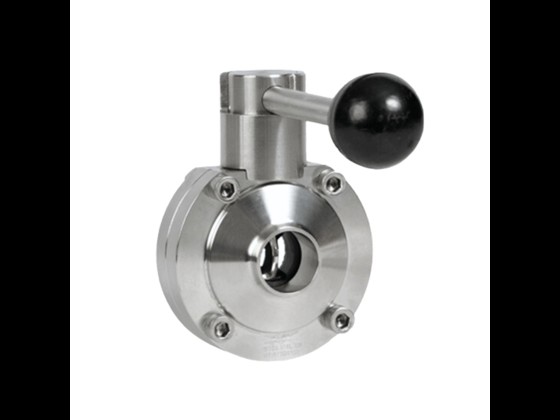
LKB butterfly valve, EPDM gasket
Made of stainless steel AISI 316, manually operated

LKB butterfly valve, HNBR gasket
Made of stainless steel AISI 316, manually operated

AWH butterfly valve, ISO
Stainless steel AISI 316, incl. EDPM gaskets

AWH butterfly valve, DIN
Stainless steel AISI 316, incl. EDPM gaskets
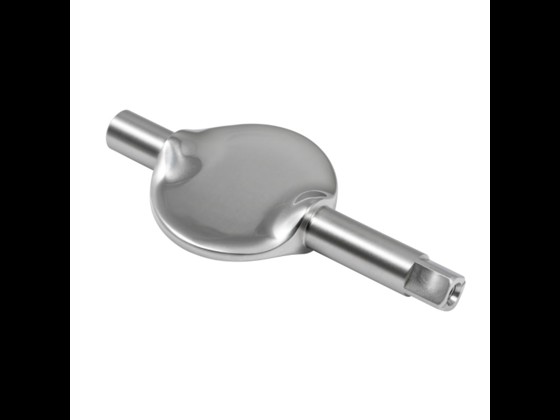
Valve disk, AWH butterfly valve, ISO
Made of stainless steel EN 1.4404 / AISI 316L
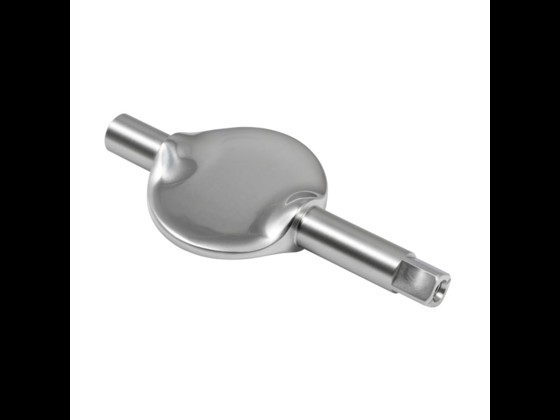
Valve disk, AWH butterfly valve, DIN
Made of stainless steel EN 1.4404 / AISI 316L
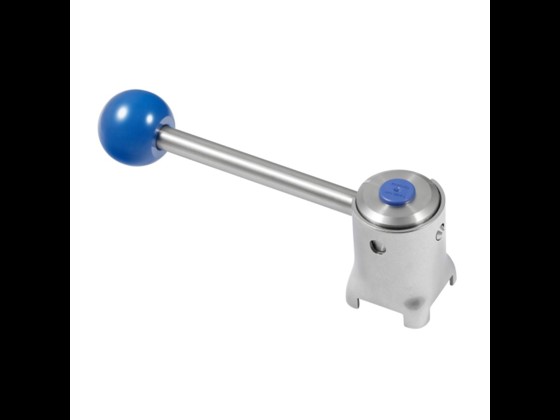
AWH butterfly valve handle, 2 positions
Made of stainless steel EN 1.4307 / AISI 304L
Butterfly valves for the process industry
We offer butterfly valves that are ideal for use in the process industry, where high demands are placed on hygiene, functionality and operational reliability. Our butterfly valves are made of AISI 316L stainless steel and are available in both manual and automated versions, depending on the application and requirements.
A butterfly valve, also known as a butterfly valve, consists of a disc that is rotated to open or close the flow. The valve has a simple and compact design and provides a reliable solution in processes where frequent opening and closing is required. Butterfly valves are widely used in the food, beverage, dairy and pharmaceutical industries, where high hygiene and efficient operation are required.
Manual and automatic butterfly valves
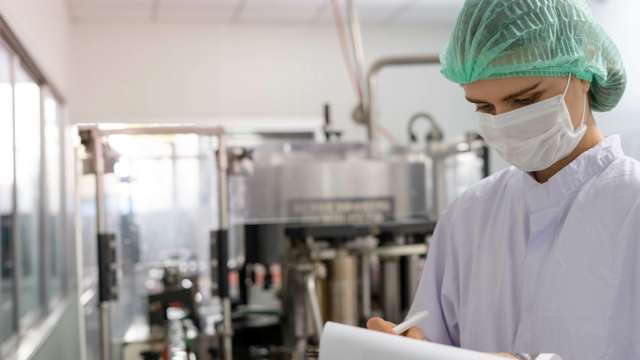
We offer both manual butterfly valves with handles and automatic versions with actuators. The manual version is suitable for smaller systems where the valve is operated locally. The automatic butterfly valve is used in larger, integrated process plants where precise control and monitoring are required.
The automatic butterfly valve can be equipped with both an actuator and a sensor box, allowing connection to an overall control system. The actuator can be either single-acting or double-acting, depending on the function required of the valve. We also offer complete valve packages with actuator and sensor box, tailored to the specific application and ready for installation. Contact us for an offer.
Materials, seals and key advantages
Our butterfly valves are available with connections in either ISO or DIN standards. The difference between the two is the size, and it is important to choose the standard that fits your system. We sell two different brands of butterfly valves: LKB valves and AWH valves. Both types are frequently used in food and dairy production as well as in chemical and pharmaceutical applications. We can also supply a wide range of spare parts for butterfly valves, including handles, disks and butterfly valve gaskets, so you can easily maintain your valve.
We offer seals in three different rubber grades: HNBR, EPDM and Viton. HNBR is a strong rubber type that excels in its ability to withstand both heat and oil. This makes it suitable for applications with high loads and aggressive media.
EPDM is suitable for handling water, steam and chemicals. The rubber is often used in the food industry due to its ability to withstand high moisture content. However, it should be noted that EPDM is not resistant to oil.
Viton can withstand very high temperatures and aggressive chemicals. The material retains its elasticity and integrity even under extreme conditions, making it a reliable choice in the chemical industry, among others.
Key advantages of butterfly valves in daily operation

Butterfly valves are an efficient and reliable solution in process plants. Their simple design, in which the disc rotates rather than moving linearly, creates minimal friction between the moving parts. This reduces wear on both the valve and the gaskets and reduces the need for maintenance.
Thanks to the compact and lightweight construction of the valves, installation is quick and flexible. They can be mounted in any direction, but for larger valves, an upright position is recommended as this relieves the load on the axle. The mounting location must be clean and free of obstacles, and the connected pipes or hoses must be correctly aligned.
The valve is secured with suitable bolts and nuts, which are tightened evenly to avoid leaks – without over-tightening. Pipes or hoses are connected with clamps or welding, and the joints are checked for leaks. Once the valve is installed, it is tested for leaks and smooth operation.
The rotating disc makes the butterfly valve easy to open and close – whether manually, electrically or pneumatically. This ensures fast and precise flow control, which is crucial in processes where control and product quality are key.
Select the right butterfly valve
To achieve optimal performance, it is important to select the butterfly valve that best matches the specific requirements of your application. Most importantly, it depends on what will flow through the valve.
Environmental conditions
It is crucial to assess the environment in which the valve will be installed. Is there an aggressive chemical atmosphere or are temperatures high? These factors determine the material from which the valve should be made.
Pressure and temperature requirements
It is necessary to select a valve that can withstand the pressure and temperature conditions of the application. Viton and HNBR are ideal for high temperatures, oil and chemical applications, while EPDM is suitable for hot liquids such as steam.
Medium type
What medium will the valve control – liquid, gas or a mixture? The nature of the medium often places specific demands on the valve materials, such as chemical resistance or wear resistance.
Frequently asked questions

What is a butterfly valve?
A butterfly valve is a type of valve with a rotating disc that regulates the flow in a pipe system. It is compact, easy to operate and suitable for frequent opening and closing.
What is the difference between manual and automatic butterfly valves?
Manual butterfly valves are operated by a handle and are used in simple systems. Automatic versions are equipped with an actuator and sensor and can be integrated into control systems for precise control.
What seals are available for butterfly valves?
We offer seals in HNBR, EPDM and Viton, depending on the medium, temperature and chemical exposure.
Are butterfly valves suitable for the food industry?
Yes, our butterfly valves are supplied with seals approved for food contact and relevant documentation in accordance with applicable EU regulations and FDA standards.
Do you offer documentation and traceability?
Yes, we provide declarations of conformity and FDA documentation as standard. Material certificates and batch numbers are available on request.
 da
da
 de
de
 en
en
 sv
sv